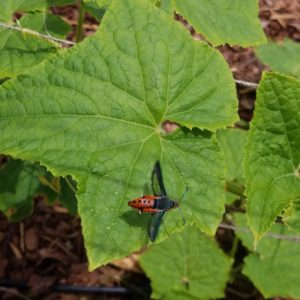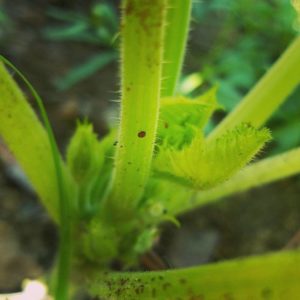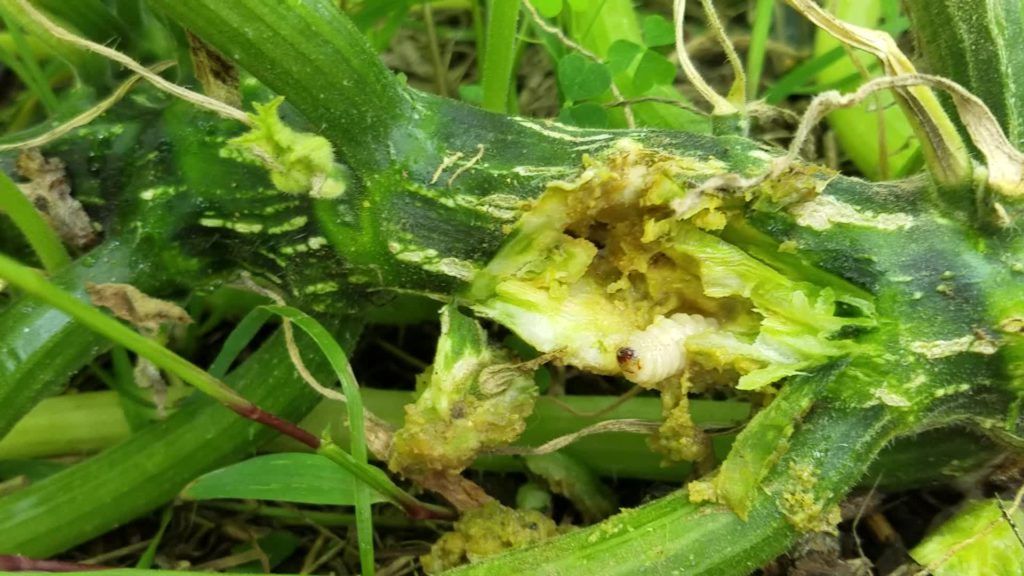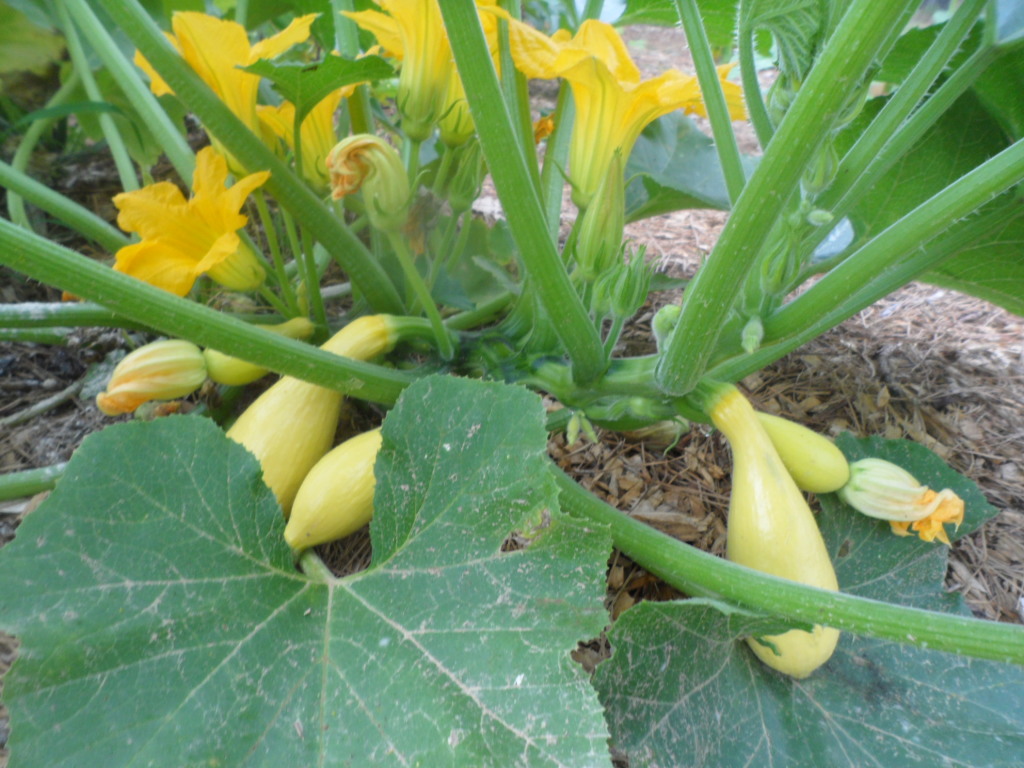Squash Vine Borer: Prevention, Identification, and Control
It was my first season gardening. The large, deep green plants held dozens of yellow babies. Just a few more days and we’d be feasting to my mom’s favorite southern dish — fried squash.
Then one day, I walked out in my garden and an entire plant’s leaves were drooping. I had no idea what was going on! Perhaps it needed water? (But we had plenty of rain.) Perhaps it was just too hot? (Then why were the others perfectly fine?)
The next day I went to the garden again and this time the plant was dead. Just like that.
Soon afterward the others succumbed to the same fate.
What went wrong?
After doing some research I realized my squash plants had been afflicted by the squash vine borer. I had never heard of it, but I quickly realized my squash and zucchini harvests every season since would depend on three things: prevention, identification, and control.

Prevent the Squash Vine Borer
While you can’t prevent the adult squash vine borer moth from seeking out your prized zucchini plants, you can take actions to prevent her babies from killing them.
First, rotate your crops each season. Squash vine borer grubs overwinter in the soil and the adult moth emerges to lay eggs and complete the cycle.
Second, as soon as your squash, zucchini, or pumpkin seedlings emerge, cover them with floating row covers to prevent the moth from landing on them. Make sure to uncover the plants when flowers appear, as bees need access to pollinate the flowers.
https://forms.convertkit.com/147664?v=7
Third, wrap stems of the plants with aluminum foil or gauze strips. When the eggs hatch, the grubs immediately bore into the stem. By covering the stem, you can prevent them from finding their way into your plants.
Although all of this advice should help with your borer problem, you may find it too labor-intensive, especially if you plant several plants. My best advice is to plan a late planting, which will skip the borer’s life cycle altogether. I plant early crops but I plan for them to succumb eventually. Then I plant a late crop around the end of July, and I’ve never had a problem with the borer. In fact, my best squash and zucchini harvests come with this late planting!
Identify the Squash Vine Borer
The adult squash vine borer moth lays eggs at the base of squash, zucchini, or pumpkin plant.

Begin inspecting the base of your squash, zucchini, and pumpkin stems. The squash vine borer eggs can look like dirt, but if you’ll look closely, you’ll see a copper-colored round egg. Scrape it off and dispose of it.

If you don’t catch these eggs, they will hatch into an ugly little grubs that burrow themselves inside the vines, where they begin eating the plant from the inside out. The first sign of borer damage is telltale yellow sawdust-like frass on the vines.
When you notice that frass, the death of the plant will soon come unless you intervene.

Control the Squash Vine Borer
Once afflicted, the squash plant will continue to suffer damage from the grub eating its way from the inside out of the stems. If you can catch it early, and if your plant is healthy and vigorous, you can dig the grub out.

I explain more about this “surgery” in the video below:
While this icky process can save the plant, I have found that if they do recover, they don’t produce as well. Sometimes, with a severe infestation, the plant doesn’t recover at all.
But I’ve found if I can catch the borer’s activity early, and the plant is healthy and vigorous, the damage will be less severe.
I have tried injecting the stem with organic pesticide (Bacterial Thurengensis), but it did not work for me. It’s worth a try though! I’ve also heard of people taking needles and puncturing the vines where the squash vine borers are likely to be (based on the trail of frass). This would effectively kill the grub in the stem without having to slice open the plant. I think this would be worth a try as well.
Bottom Line
The bottom line for my garden is this: the borer is just an enemy I have to deal with as best I can. And a big key to my success in squash and zucchini is multiple plantings. With a long season like ours (frost-free from March 31 – November 15), I usually plant three different plantings (one in early April, one in mid-June, and one in late July). Not only does this give us squash and zucchini for most of the summer and fall, but when I eventually lose the plant when I’m unable to keep up, I’ve got another crop on its way.
Have you had success controlling the squash vine borer?
Do you get overwhelmed with garden planning?

Subscribe here for my best tips to plan your garden in just 7 days -- all for FREE.
Plus, I'll send you my "In the Garden E-mail" on Fridays, periodic updates on garden resources relevant to you, and you'll receive access to my entire bank of free garden downloads!
You are also agreeing to our privacy policy.


Hi Jill! I just found out about the squash vine borer and am trying to do some preventative things and found your website.
I’m in zone 8b. How do I find out when the squash vine borers are done here and when would be good times to plant here to avoid them completely?
I think the only way to know is to test it. Personally, in zone 7b, I can plant in late July and escape the borer. I would think the timing of your planting would be fairly similar. You could try late July, or you could try a bit later since your frost date is likely later than mine. That’s the key — to plant late enough to avoid the life cycle but early enough to get a full harvest before frost knocks out your plants.
I’ve recently lost 2 squash and 1 zucchini plants but luckily I was able to nurse one plant back to health. It’s not producing a lot, but producing some nonetheless. I find the little copper eggs on the leaves most of the time but have never looked for them on the stems. I’ve had squash bugs cover the stem at times and used Take Down. Someone told me that would prevent my pollinators to come around though. Have you used it as a deterrent/prevention? I’m in zone 8a Fort Worth, Texas. Thank you!
I have not used Take Down. It’s primary ingredient is pyrethrin, which is a powerful organically-derived insecticide. But it’s a broad-spectrum insecticide that can kill beneficial insects as well as pest insects. I would definitely keep it away from flowers at all costs, and it’s better than non-organic options. I don’t know how effective it is against squash bugs, though. Personally, I don’t use anything for my squash bugs/borers. I hand-pick when I can and just plan for multiple plantings throughout the season — knowing I’ll lose some plants.
Thanks for explaining your methods. I’m curious though about the organic commercial gardeners who have maybe dozens of plants, and I can’t see that they would spend so much time with such a labor intensive approach. Do you know what they do? I’ve seen a suggestion on the web for “row covers,” which are a kind of netting that prevents the moth from laying eggs. Are you familiar with this or any other method commercial growers use? Thanks.
I have thought the same thing, so one year when my son’s class went to a pumpkin patch for a field trip, I asked one of the workers what they do to prevent the borer. The worker had no idea so I guess I asked the wrong person. I really have no idea! I am sure they apply some commercial insecticide — that’s all I can think of. In my area, the row covers would be needed at the same time as pollination so I don’t see how that would work in my location.
Well so far I have done Surgery to Two of my squash/zucchini plants. One is standing up looking great, however my cupcake squash wilted immediately. Any suggestions ? It had 2 baby’s on it… I did the good dirt covering ???
In my experience, sometimes the surgery works and sometimes it doesn’t. It’s based on how early I caught the problem because sometimes the surgery needed is so extensive the plant can’t recover. Any time we cut any part of the stem, we’re limiting the water flow, which would explain why one wilted and hasn’t recovered. I’d suggest replanting. That’s what I do now — I don’t even mess with cutting the stem open anymore.
When you say you are starting a July planting is that direct seed sow into the garden or seeds you’ve started indoors?
Direct sow in the garden. Seeds sprout quickly in the warm soil.
Like someone else said, I never thought of looking on the stems for the eggs but I spend a lot of time searching for cucumber beetle eggs too. I have never seen the “frass” you refer to and I’m out there twice a day looking. Most of my squashes have the borer, I’m pretty sure. I tried the surgery on a couple of plants and thin I helped one but not the others. I was surprised to find 4 worms in one stem. I find it pretty hard to slit the stem and not ruin it trying to get a worm out or look for a worm. Early on this year I noticed squash bugs as well as cucumber beetles congregating around the base of all my squash plants so I tried putting ground red pepper at the base of the plant and they disappeared for quite some time and never came back like they were in the beginning, just an occasional beetle or squash bug. I have tried the foil around the stems and this year tried the ace bandage that I read about. Obviously it didn’t help. I just planted a few more squash seeds, first time I have done a late planting, so we will see!
Hello Jill,
I have 2 butternut squash plants, planted in May. One plant is in a large container and I have about 7 butternut but they are very small, about 3 to 6 inches. Now beige in color and getting deeper peach color. Skin is firm. Unfortunately tonight I discovered squash vine borer activity and pulled one out of a vine that is almost split in two. I am devastated! My question is should I early harvest the squash if the vine dies and how the heck did this happen when butternut are supposed to be resistant to SVB in the first place! I lost 5 zucchini and squash plants to SVB in June. I am in NC.
Hi Trish, I’m so sorry this happened to you! I don’t grow butternut squash, but from what I understand, it won’t continue to ripen after it’s picked. If the borer you noticed only affected one stem, perhaps you’ll only lose that vine and the others will remain in tact. That’s what I have found with my tromboncino squash just this week. It’s supposed to be borer resistant, too, and it has been so far on the main stem but I’ve found it in side branches. So far, I’ve been able to only lose one stem but not the entire plant.